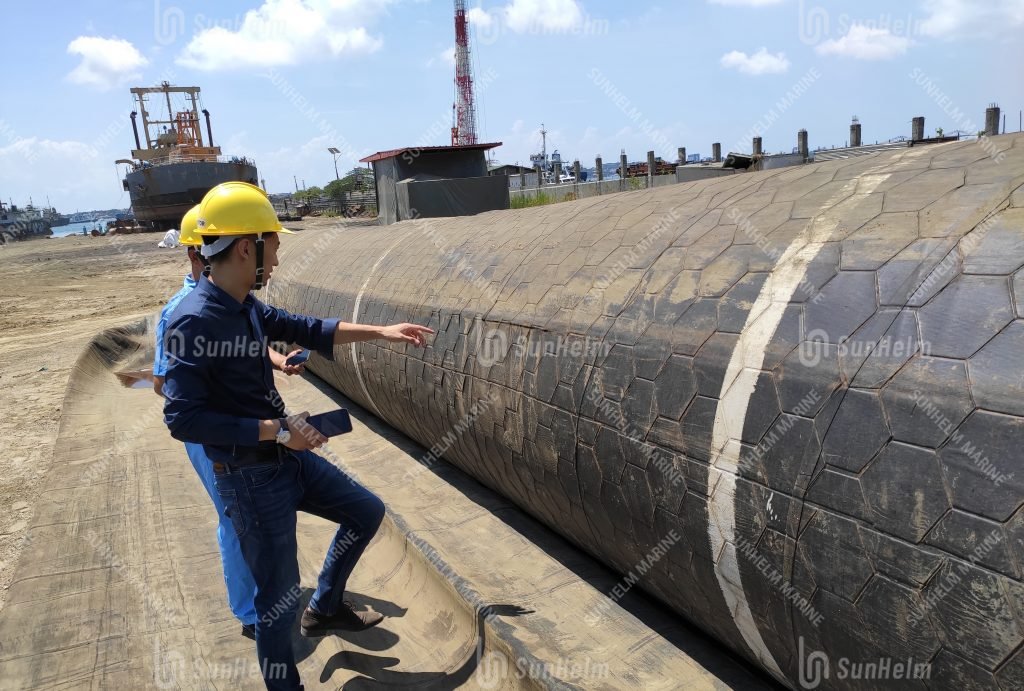SunHelm Marine built the Bee Nest Airbag to meet the real needs of shipyards that work in the toughest places on earth. These next-generation ship launching airbags keep all the proven benefits of our classic airbags and add a high-strength anti-puncture composite layer plus a honeycomb surface design. The result: a cold-resistant, extra-tough airbag that protects hulls, improves safety, and lasts far longer in extreme conditions — especially in high-latitude ports like Russia, Northern Europe, and Canada.

What Bee Nest Airbags Are
Bee Nest Airbags are SunHelm Marine’s new ship launching airbags. We use world-leading materials and our own manufacturing steps to make airbags that:
- Resist punctures and scratches from sharp objects.
- Keep their flexibility at very low temperatures.
- Absorb impact energy and lower reaction forces on the hull.
- Work reliably in extreme cold and rough job sites.
We named the product for its hexagonal, honeycomb-like surface. That surface, together with the extra composite layer, boosts puncture resistance by about 100% compared with standard surfacing.
Key Features — Simple and Strong
High-strength anti-puncture composite layer
SunHelm adds a tough composite layer under the outer skin. This layer stops small cuts and punctures from growing into leaks. Shipyards can operate with less worry about sharp debris on the slipway or in the water.
Honeycomb surface design
The outer surface uses hexagonal patterns. The pattern spreads local forces and resists penetration. It also helps the airbag flex in a controlled way when it rolls under a hull.
Cold-rated materials and process
We select and test rubber blends and coatings that keep flexibility in freezing temperatures. We also use manufacturing methods that avoid weak points that can appear in cold-made parts.
Proprietary manufacturing technology
Our process controls layer bonding, wall thickness, and seam strength. That control keeps airbags stable under heavy loads and repeated use.
How Bee Nest Airbags Improve Launching
Bee Nest Airbags change several key risks in a launch:
- They absorb impact energy more evenly, which reduces sudden hull reaction forces.
- They resist accidental punctures, so launches face fewer delays and repairs.
- They keep cushioning power in very low temperatures, so cold-water launches stay safe.
- They last longer, which lowers replacement and downtime costs over the life of the airbag.
Together, these improvements make launches faster, safer, and cheaper to run over time.
Built for High-Latitude and Harsh Environments
Shipyards that work in Russia, Northern Europe, and Canadian ports face two linked problems: cold temperatures and rough, debris-filled slipways or open water. Bee Nest Airbags address both:
- The cold-rated rubber keeps the airbag soft enough to absorb shocks even below freezing.
- The anti-puncture composite and honeycomb surface resist cuts from rubble, steel, and ice.
- The combined design reduces the chance of sudden failure during launch or retrieval.
For yards that run year-round or do seasonal work in Arctic or sub-Arctic waters, Bee Nest Airbags reduce risk and simplify planning.
Typical Applications
You can use Bee Nest Airbags for:
- Ship launching of new builds (small patrol boats up to larger merchant hulls).
- Ship recovery and salvage in cold waters.
- Docking or mooring operations where contact with rough surfaces could occur.
- Offshore operations that need temporary cushioning under hulls or structures.
We design each set to match vessel size, weight, and slipway geometry. SunHelm offers custom sizing and tailored laydown plans.
Maintenance and Lifespan
Bee Nest Airbags need the same basic care as other ship launching airbags: clean the surface after use, avoid long contact with sharp edges, and follow proper inflation procedures. Because of the extra anti-puncture layer and tough surface, Bee Nest Airbags show a significant increase in service life compared with standard models. That improvement cuts lifecycle cost and reduces the need for frequent replacements.
FAQ
Q: Do Bee Nest Airbags work in extreme cold?
A: Yes. We design materials and production to keep cushioning performance in freezing conditions.
Q: How do they resist punctures?
A: A high-strength composite layer plus a honeycomb surface spread forces and stop cuts from turning into leaks. We measure about a 100% gain in puncture resistance versus a standard surface.
Q: Can SunHelm customize sizes?
A: Yes. We tailor diameter, length, and wall thickness to meet each ship and launching site.


